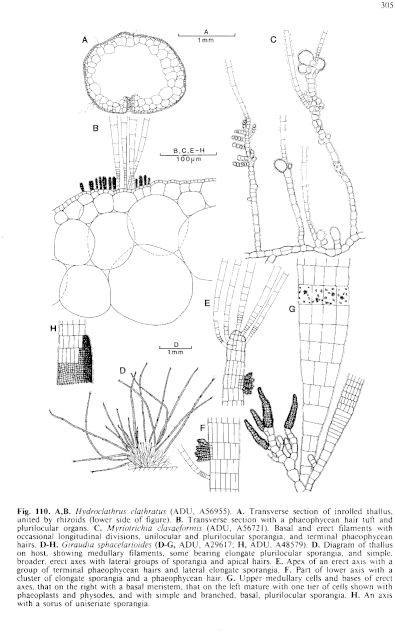|
|
|
|
|
|||||||||||
|
Electronic Flora of South Australia Species Fact Sheet
Phylum Phaeophyta – Order Dictyosiphonales – Family Giraudiaceae
Selected citations: Hamel 1937: 189, fig. 42(1–8). Kuckuck 1929: 28, figs 19–25. Sauvageau 1927a: 1, figs 1–18. Skinner & Womersley 1984: 164, figs 1–10. Womersley 1967: 243.
Thallus (Fig. 1 10D) medium to dark brown, (1–) 2–6 mm high, pulvinate with free, flexible, erect axes, epiphytic on Posidonia spp. (rarely on algae, e.g. Caulocystis). Basal plate monostromatic, of compact or loose radiating filaments on the host surface. Medullary filaments developing in older plants, uniseriate, branched, 200–500 µm long and 10–20 µm in diameter with cells L/B (1–) 1.5–3, with the terminal cells bearing the erect, polystichous axes or basal, plurilocular sporangia. Erect axes (Fig. 110D–G) terete, filiform, 1–4 mm long, 50–80 (–100) in diameter, flexible, lower cells mostly biseriate (with buttress rhizoids), then a uniseriate meristem (Fig. 110G, right) of 4–15 short cells (becoming fewer then not present in mature axes-Fig. 110G), with the upper axis of tiers of 10–12 (–15) cells, four-sided in face view (Fig. 110G) and (5–) 8–12 (–18) µm across, L/B (1–) 1.5–2, tapering to the apex (usually uniseriate), cells with numerous discoid to elongate phaeoplasts each with a pyrenoid, and prominent physodes. Phaeophycean hairs terminal (Fig. 110E) in groups of 1–6 and lateral on the axes, 8–10 (–15) µm in diameter.
Microthallus discoid, 50–200 µm across, with short, erect filaments (40–100 µm long), ascocysts and plurilocular sporangia to the same height as the filaments.
Reproduction: Reproduction by plurilocular sporangia of three types, all reproducing the macrothallus directly or via the microthallus. (1) Basal, discrete, elongate sporangia (Fig. 110G), multiseriate, simple or often branched, borne on upper medullary cells, 50–100(450) µm long and 5–18 µm in diameter. (2). Lateral, elongate, clustered sporangia (Fig. 110E,F) developing from 1–4 axis cells, each 20–50 µm long and 8–10 µm in diameter. (3). Sporangia developed by subdivision of groups of axis cells (Fig. 110H), elongate, uniseriate, 15–25 µm and 4–6 locules long, 3–5 µm in diameter.
Type from the Mediterranean; location unknown.
Selected specimens: Fishhook Bay, Rottnest I., W. Aust., on Posidonia australis, upper sublittoral (Gordon-Mills, 6.xii.1984; ADU, A56662). Troubridge I., S. Aust., on Posidonia, 17 m deep (Shepherd, 4.ii.1969; ADU, A33441). Investigator Strait, S. Aust., 27 m deep, 35°14'S, 137°30'E ( Watson, 10.i.1971; ADU, A38460). Saunders Beach, Eastern Cove, Kangaroo I., S. Aust., on P. sinuosa, drift (Womersley, 25.viii.1963; ADU, A26704). Marino, S. Aust., on Amphibolis stem, drift ( Womersley, 23.i.1972; ADU, A41266). Aldinga, S. Aust., on P. australis, upper sublittoral pool (Womersley, 11.x.1965; ADU, A29617; Skinner, 16.viii.1977; ADU, A48226 and 14.x.1977; ADU, A48579). Stewarts Bay, Port Arthur, Tas., on Caulocystis cephalornithos, drift ( Womersley, 30.x.1982; ADU, A55789).
Distribution: Europe, Mediterranean, N.E. N. America.
In southern Australia, from Rottnest I., W. Aust. to Kingston, S. Aust. and Port Arthur, Tas. (probably further east and around Tasmania).
Taxonomic notes: The Australian specimens agree well vegetatively and reproductively with those from the Mediterranean.
References:
DERBÉS, A. & SOLIER, A.J.J. (1851). Algues. In Castagne, J.L.M., Supplément au Catalogue des plantes qui croissent naturellement aux environs de Marseille. pp. 93–121. (Nicot & Pardigon: Aix.)
HAMEL, G. (1937). Phéophycées de France. Fasc. III, pp. 177–240. (Paris.)
KUCKUCK, P. (1929). Fragmente einer Monographie des Pheosporeen. Biol. Anst. Helgol. 17, 1–93.
SAUVAGEAU, C. (1927a). Sur les problèmes du Giraudya. Bull. Stn biol. Arcachon 24, 1–74.
SKINNER, S. & WOMERSLEY, H.B.S. (1984). Southern Australian taxa of Giraudiaceae (Dictyosiphonales, Phaeophyta). Phycologia 23, 161–181.
WOMERSLEY, H.B.S. (1967). A critical survey of the marine algae of southern Australia. II. Phaeophyta. Aust. J. Bot. 15, 189–270.
The Marine Benthic Flora of Southern Australia Part II complete list of references.
Publication:
Womersley, H.B.S. (14 December, 1987)
The Marine Benthic Flora of Southern Australia
Part II
©Board of the Botanic Gardens and State Herbarium, Government of South Australia
Illustration in Womersley Part II, 1997: FIG. 110 D–H.

Figure 110 enlarge
Fig. 110. A,B. Hydroclathrus clathratus (ADU, A56955). A. Transverse section of inrolled thallus, united by rhizoids (lower side of figure). B. Transverse section with a phaeophycean hair tuft and plurilocular organs. C. Myriotrichia clavaefortnis (ADU, A56721). Basal and erect filaments with occasional longitudinal divisions, unilocular and plurilocular sporangia, and terminal phaeophycean hairs. D–H. Giraudia sphacelarioides (D–G, ADU, A29617; H, ADU, A48579). D. Diagram of thallus on host, showing medullary filaments, some bearing elongate plurilocular sporangia, and simple, broader, erect axes with lateral groups of sporangia and apical hairs. E. Apex of an erect axis with a group of terminal phaeophycean hairs and lateral elongate sporangia. F. Part of lower axis with a cluster of elongate sporangia and a phaeophycean hair. G. Upper medullary cells and bases of erect axes, that on the right with a basal meristem, that on the left mature with one tier of cells shown with phaeoplasts and physodes, and with simple and branched, basal, plurilocular sporangia. H. An axis with a sorus of uniseriate sporangia.

|
Email Contact: State Herbarium of South Australia |

|